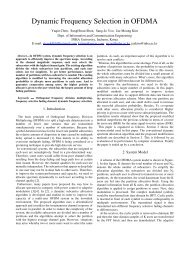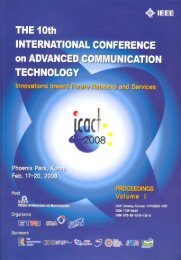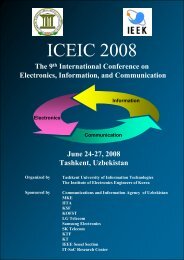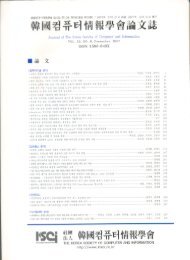Dynamic Frequency Allocation Based On Graph Coloring and Local ...
Dynamic Frequency Allocation Based On Graph Coloring and Local ...
Dynamic Frequency Allocation Based On Graph Coloring and Local ...
Create successful ePaper yourself
Turn your PDF publications into a flip-book with our unique Google optimized e-Paper software.
vertex. The equivalent graph coloring problem is to<br />
color each vertex using a number of colors from its color<br />
list, such that if a color m edge exists between any two<br />
distinct vertices, they can’t be colored with m<br />
simultaneously. We name this the color-sensitive graph<br />
coloring (CSGC) problem [4].<br />
Fig. 1 illustrates an example of CSGC graph. There<br />
are five colors available. The numbers outside the<br />
brackets attached to each node denote the colors<br />
assigned to that node, while the numbers inside the<br />
brackets denote the available color list of each node.<br />
Fig.1. An example of GMC graph<br />
A CSGC problem is to color each vertex using a<br />
number of colors from its color list, <strong>and</strong> find the color<br />
assignment that maximizes system utility. The coloring<br />
is constrained by that if an edge exists between any two<br />
distinct vertices, they can’t be colored with the same<br />
color. Most importantly, the objective of coloring is to<br />
maximize system utility. This is different from<br />
traditional graph color solutions that assign one color<br />
per vertex. Notice that the solution to this graph coloring<br />
problem is to maximize system utility for a given graph,<br />
i.e. a given topology <strong>and</strong> channel availability. This<br />
characterizes the optimal solution for a static<br />
environment.<br />
The optimal coloring problem is known to be NPhard.<br />
Efficient algorithms to optimize spectrum<br />
allocation for a given network topology exist. In [4], the<br />
authors presented a set of sequential heuristic based<br />
approaches that produce good coloring solutions. The<br />
algorithm starts from the empty color assignment <strong>and</strong><br />
iteratively assigns colors to vertices to approximate the<br />
optimal assignment. In each stage, the algorithm labels<br />
all the vertices with a non-empty color list according to<br />
some policy-defined labeling. The algorithm picks the<br />
vertex with the highest valued label <strong>and</strong> assigns the<br />
color associated with the label to the vertex. The<br />
algorithm then deletes the color from the vertex’s color<br />
list, <strong>and</strong> from the color lists of the constrained neighbors.<br />
The color list <strong>and</strong> the interference constraint of a vertex<br />
keep on changing as other vertices are processed, <strong>and</strong><br />
the labels of the colored vertex <strong>and</strong> its neighbor vertices<br />
are modified according to the new graph. The algorithm<br />
can be implemented using a centralized controller who<br />
observes global topology <strong>and</strong> makes decisions or<br />
through a distributed algorithm where each vertex<br />
performs a distributed voting process. Results in [4]<br />
show that the heuristic based algorithms perform<br />
similarly to the global optimum (derived off-line for<br />
simple topologies), <strong>and</strong> the centralized <strong>and</strong> distributed<br />
algorithms perform similarly.<br />
C. SPECTRUM ALLOCATION ALGORITHM FOR MULTI-<br />
CELL WRAN SYSTEM<br />
1st. Spectrum <strong>Allocation</strong> for Multi-cell WRAN<br />
System<br />
In WRAN system case, the users in the same cell<br />
cannot select the same spectrum b<strong>and</strong>width at the same<br />
time. In addition, the users coming from adjacent cells<br />
also suffer co-channel interference if they locate within<br />
the constrained distance from each other. Therefore, we<br />
consider the users as the vertices in the coloring graph.<br />
The users from adjacent cells which locate within the π<br />
distance are connected by the constraints with the edge.<br />
Fig. 2 illustrates the CSGC example of multi-cell<br />
WRAN system. At the boundaries of the cells, users<br />
coming from different cells conflict each other while<br />
selecting the same spectrum at the same time.<br />
Fig.2. CSGC example of multi-cell WRAN system<br />
The spectrum allocation for multi-cell WRAN system<br />
begins from the central cell <strong>and</strong> then to the outer cells.<br />
And an allocation approach called “pre-allocation <strong>and</strong><br />
local bargaining” is applied. In the pre-allocation stage,<br />
all users try to select the maximum required number of<br />
spectrum b<strong>and</strong>width. Actually, probably many users<br />
cannot be assigned enough b<strong>and</strong>width. To satisfy the<br />
minimum required b<strong>and</strong>width of all users, the users<br />
allocated with less than minimum required b<strong>and</strong>width<br />
have the right to borrow some b<strong>and</strong>width from its<br />
neighbors locating within the constraint distance.<br />
Detailed description of the spectrum allocation is<br />
following:
















